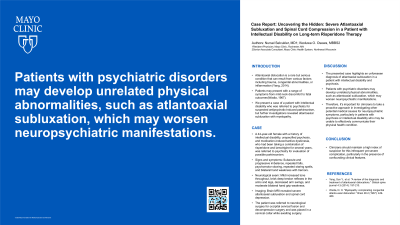Neurocognitive Disorders, Delirium, and Neuropsychiatry
Session: Poster Session
(088) Uncovering the Hidden: Severe Atlantoaxial Subluxation and Spinal Cord Compression in a Patient with Intellectual Disability on Long-term Risperidone Therapy

Trainee Involvement: Yes

Nursel Selcukler, MD (she/her/hers)
Resident Physician
Mayo Clinic
Altoona, Wisconsin, United States- IO
Ifeoluwa O. Osewa, MBBS
Senior Associate Consultant
Mayo Clinic Health System, Northwest Wisconsin
Eau Claire, Wisconsin, United States
Presenting Author(s)
Co-Author(s)
Background:
Atlantoaxial dislocation is a rare but serious condition that can result from various factors including trauma, congenital abnormalities, or inflammation (Yang, 2014). Patients may present with a range of symptoms from mild neck discomfort to fatal outcomes (Wadia, 1967). We present a case of a patient with intellectual disability who was referred to psychiatry for suspected antipsychotic-induced parkinsonism, but further investigations revealed atlantoaxial subluxation with myelopathy.
Case:
A 44-year-old female with a history of intellectual disability, unspecified psychosis, and medication-induced tardive dyskinesia, who had been taking a combination of risperidone and lamotrigine for several years, was referred to psychiatry for evaluation of possible parkinsonism. Her symptoms included progressive imbalance, repeated falls, psychomotor slowing, repeated staring spells, and bilateral hand weakness with tremor. Neurological evaluation revealed mild increased tone throughout, brisk deep tendon reflexes in the arms and legs, decreased arm swings, and moderate bilateral hand grip weakness. Brain MRI demonstrated severe atlantoaxial subluxation and spinal cord depression. The patient was referred to neurological surgery for occipital cervical fusion and decompression surgery and is currently using a cervical collar while awaiting surgery.
Discussion:
The presented case highlights an unforeseen diagnosis of atlantoaxial subluxation in a patient with intellectual disability and psychosis. Patients with psychiatric disorders may develop unrelated physical abnormalities, such as atlantoaxial subluxation, which may worsen neuropsychiatric manifestations. Therefore, it's important for clinicians to take a proactive approach in investigating other potential medical causes for neuropsychiatric symptoms, particularly in patients with psychosis or intellectual disability who may be unable to effectively communicate their physical health condition.
Conclusion:
Clinicians should maintain a high index of suspicion for this infrequent yet severe complication, particularly in the presence of confounding clinical features.
References:
Yang, Sun Y., et al. "A review of the diagnosis and treatment of atlantoaxial dislocations." Global spine journal 4.3 (2014): 197-210.
Wadia, N. H. "Myelopathy complicating congenital atlanto-axial dislocation." Brain 90.2 (1967): 449-480.

